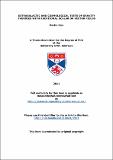Files in this item
Extragalactic and cosmological tests of gravity theories with additional scalar or vector fields
Item metadata
| dc.contributor.author | Feix, Martin | |
| dc.coverage.spatial | 174 | en_US |
| dc.date.accessioned | 2011-06-23T12:12:16Z | |
| dc.date.available | 2011-06-23T12:12:16Z | |
| dc.date.issued | 2011-06-24 | |
| dc.identifier.uri | https://hdl.handle.net/10023/1901 | |
| dc.description.abstract | Despite the many successes of the current standard model of cosmology on the largest physical scales, it relies on two phenomenologically motivated constituents, cold dark matter and dark energy, which account for approximately 95% of the energy-matter content of the universe. From a more fundamental point of view, however, the introduction of a dark energy (DE) component is theoretically challenging and extremely fine-tuned, despite the many proposals for its dynamics. On the other hand, the concept of cold dark matter (CDM) also suffers from several issues such as the lack of direct experimental detection, the question of its cosmological abundance and problems related to the formation of structure on small scales. A perhaps more natural solution might be that the gravitational interaction genuinely differs from that of general relativity, which expresses itself as either one or even both of the above dark components. Here we consider different possibilities on how to constrain hypothetical modifications to the gravitational sector, focusing on the subset of tensor-vector-scalar (TeVeS) theory as an alternative to CDM on galactic scales and a particular class of chameleon models which aim at explaining the coincidences of DE. Developing an analytic model for nonspherical lenses, we begin our analysis with testing TeVeS against observations of multiple-image systems. We then approach the role of low-density objects such as cosmic filaments in this framework and discuss potentially observable signatures. Along these lines, we also consider the possibility of massive neutrinos in TeVeS theory and outline a general approach for constraining this hypothesis with the help of cluster lenses. This approach is then demonstrated using the cluster lens A2390 with its remarkable straight arc. Presenting a general framework to explore the nonlinear clustering of density perturbations in coupled scalar field models, we then consider a particular chameleon model and highlight the possibility of measurable effects on intermediate scales, i.e. those relevant for galaxy clusters. Finally, we discuss the prospects of applying similar methods in the context of TeVeS and present an ansatz which allows to cast the linear perturbation equations into a more convenient form. | en_US |
| dc.language.iso | en | en_US |
| dc.publisher | University of St Andrews | |
| dc.subject | Alternative relativistic models | en_US |
| dc.subject | Cosmology: Theory | en_US |
| dc.subject | Dark energy | en_US |
| dc.subject | Dark matter | en_US |
| dc.subject | General relativity | en_US |
| dc.subject | Gravitational lensing | en_US |
| dc.subject | Physics beyond the standard model | en_US |
| dc.subject | Structure formation | en_US |
| dc.subject.lcc | QC178.F45 | |
| dc.subject.lcsh | Gravitation | en_US |
| dc.subject.lcsh | Cosmology | en_US |
| dc.subject.lcsh | General relativity (Physics) | en_US |
| dc.subject.lcsh | Dark energy (Astronomy) | en_US |
| dc.subject.lcsh | Dark matter (Astronomy) | en_US |
| dc.subject.lcsh | Gravitational lenses | en_US |
| dc.title | Extragalactic and cosmological tests of gravity theories with additional scalar or vector fields | en_US |
| dc.type | Thesis | en_US |
| dc.contributor.sponsor | Scottish Universities Physics Alliance (SUPA) | en_US |
| dc.type.qualificationlevel | Doctoral | en_US |
| dc.type.qualificationname | PhD Doctor of Philosophy | en_US |
| dc.publisher.institution | The University of St Andrews | en_US |
| dc.publisher.department | Scottish Universities Physics Alliance (SUPA) | en_US |
This item appears in the following Collection(s)
Items in the St Andrews Research Repository are protected by copyright, with all rights reserved, unless otherwise indicated.

